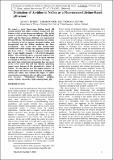| dc.contributor.author | Ryder, Alan G. | |
| dc.contributor.author | Power, Sarah | |
| dc.contributor.author | Glynn, Thomas J. | |
| dc.date.accessioned | 2012-08-22T09:59:43Z | |
| dc.date.available | 2012-08-22T09:59:43Z | |
| dc.date.issued | 2003 | |
| dc.identifier.citation | Ryder, AG,Power, S,Glynn, TJ (2003) 'Evaluation of acridine in Nafion as a fluorescence-lifetime-based pH sensor'. Applied Spectroscopy, 57 (1):73-79. | en_US |
| dc.identifier.issn | 1943-3530 | |
| dc.identifier.uri | http://www.opticsinfobase.org/as/abstract.cfm?URI=as-57-1-73 | |
| dc.identifier.uri | http://hdl.handle.net/10379/2928 | |
| dc.description | Journal article | en_US |
| dc.description.abstract | We report a novel fluorescence-lifetime-based pH sensing method that utilizes acridine incorporated into Nation (AcNaf) as the fluorescent indicator. The AcNaf sensor is excited using a 380 nm light emitting diode (LED) and the fluorescence lifetimes are measured at 450 and 500 nm. The fluorescence behavior of acridine as a function of pH in aqueous phosphate buffers and incorporated into the Nation membrane has been investigated. The results show that incorporating acridine into Nation changes the apparent ground-state pK(a) from similar to5.45 to similar to9, while the apparent excited-state pK(a)* is only slightly changed (similar to9.4 in 0.1 M phosphate buffer). The AcNaf film shows a good pH response with a change in average lifetime of similar to19 ns (at an emission wavelength of 450 nm) over the pH 8 to 10 range. We also show that excited-state protonation does not occur in the AcNaf sensor film and that chloride quenching cannot occur because of the permselective nature of Nafion. We also discuss how the unique structure of Nation affects the fluorescence behavior of acridine at various pH values and examine the impact of buffer concentration on apparent pK(a) and pH sensing ability. | en_US |
| dc.description.sponsorship | NUI Galway Millennium Research Grant; Enterprise Ireland Research Innovation Fund (IF/2001/061); HEA Programme for Research | en_US |
| dc.format | application/pdf | en_US |
| dc.language.iso | en | en_US |
| dc.relation.ispartof | Applied Spectroscopy | en |
| dc.rights | Attribution-NonCommercial-NoDerivs 3.0 Ireland | |
| dc.rights.uri | https://creativecommons.org/licenses/by-nc-nd/3.0/ie/ | |
| dc.subject | Fluorescence lifetime | en_US |
| dc.subject | Acridine | en_US |
| dc.subject | Sensor | en_US |
| dc.subject | Nafion | en_US |
| dc.subject | Ultraviolet | en_US |
| dc.subject | Light emitting diode | en_US |
| dc.subject | pH | en_US |
| dc.subject | Time-resolved fluorescence | en_US |
| dc.subject | Light-emitting diode | en_US |
| dc.subject | Phase-modulation fluorometry | en_US |
| dc.subject | Optical sensors | en_US |
| dc.subject | Silica-gel | en_US |
| dc.subject | Decay time | en_US |
| dc.subject | Nanosecond | en_US |
| dc.subject | Luminescence | en_US |
| dc.subject | State | en_US |
| dc.subject | Absorption | en_US |
| dc.title | Evaluation of acridine in Nafion as a fluorescence-lifetime-based pH sensor | en_US |
| dc.type | Article | en_US |
| dc.date.updated | 2012-08-17T12:55:16Z | |
| dc.local.publishedsource | http://www.opticsinfobase.org/as/abstract.cfm?URI=as-57-1-73 | en_US |
| dc.description.peer-reviewed | peer-reviewed | |
| dc.contributor.funder | |~| | |
| dc.internal.rssid | 1346951 | |
| dc.local.contact | Alan Ryder, School Of Chemistry, Room 228, Arts/Science Building, Nui Galway. 2943 Email: alan.ryder@nuigalway.ie | |
| dc.local.copyrightchecked | No | |
| dc.local.version | ACCEPTED | |
| nui.item.downloads | 780 | |


